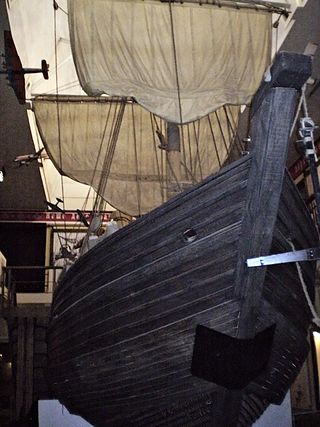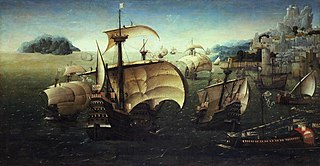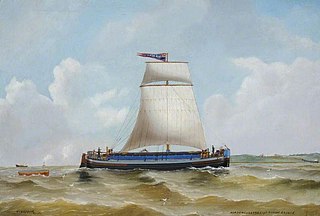
A ship is a large watercraft that travels the world's oceans and other sufficiently deep waterways, carrying cargo or passengers, or in support of specialized missions, such as defense, research and fishing. Ships are generally distinguished from boats, based on size, shape, load capacity and purpose. Ships have supported exploration, trade, warfare, migration, colonization, and science. After the 15th century, new crops that had come from and to the Americas via the European seafarers significantly contributed to world population growth. Ship transport is responsible for the largest portion of world commerce.

A sailing ship is a sea-going vessel that uses sails mounted on masts to harness the power of wind and propel the vessel. There is a variety of sail plans that propel sailing ships, employing square-rigged or fore-and-aft sails. Some ships carry square sails on each mast—the brig and full-rigged ship, said to be "ship-rigged" when there are three or more masts. Others carry only fore-and-aft sails on each mast, for instance some schooners. Still others employ a combination of square and fore-and-aft sails, including the barque, barquentine, and brigantine.

Galleons were large, multi-decked sailing ships first used as armed cargo carriers by European states from the 16th to 18th centuries during the age of sail and were the principal vessels drafted for use as warships until the Anglo-Dutch Wars of the mid-1600s. Galleons generally carried three or more masts with a lateen fore-and-aft rig on the rear masts, were carvel built with a prominent squared off raised stern, and used square-rigged sail plans on their fore-mast and main-masts.
Shipbuilding is the construction of ships and other floating vessels. It normally takes place in a specialized facility known as a shipyard. Shipbuilders, also called shipwrights, follow a specialized occupation that traces its roots to before recorded history.

The caravel is a small maneuverable sailing ship used in the 15th century by the Portuguese to explore along the West African coast and into the Atlantic Ocean. The lateen sails gave it speed and the capacity for sailing windward (beating). Caravels were used by the Portuguese and Castilians for the oceanic exploration voyages during the 15th and 16th centuries, during the Age of Discovery.

The koch was a special type of small one or two mast wooden sailing ships designed and used in Russia for transpolar voyages in ice conditions of the Arctic seas, popular among the Pomors.

A cog is a type of ship that first appeared in the 10th century, and was widely used from around the 12th century on. Cogs were clinker-built, generally of oak. These vessels were fitted with a single mast and a square-rigged single sail. They were mostly associated with seagoing trade in north-west medieval Europe, especially the Hanseatic League. Typical seagoing cogs ranged from about 15 to 25 meters in length, with a beam of 5 to 8 meters and were 30–200 tons burthen. Cogs were rarely as large as 300 tons although a few were considerably larger, over 1,000 tons.

Carvel built or carvel planking is a method of boat building in which hull planks are laid edge to edge and fastened to a robust frame, thereby forming a smooth surface. Traditionally the planks are neither attached to, nor slotted into, each other, having only a caulking sealant between the planks to keep water out. Modern carvel builders may attach the planks to each other with glues and fixings. It is a "frame first" method of hull construction, where the shape is determined by the framework onto which the planks are fixed. This is in contrast to "plank first" or "shell first" methods, where the outer skin of the hull is made and then reinforced by the insertion of timbers that are fitted to that shape. The most common modern "plank first" method is clinker construction; in the classical period "plank first" involved joining the edges of planks with mortise and tenon joints within the thickness of the timbers, superficially giving the smooth-hull appearance of carvel construction, but achieved by entirely different means.

Boat building is the design and construction of boats and their systems. This includes at a minimum a hull, with propulsion, mechanical, navigation, safety and other systems as a craft requires.

A carrack is a three- or four-masted ocean-going sailing ship that was developed in the 14th to 15th centuries in Europe, most notably in Portugal. Evolved from the single-masted cog, the carrack was first used for European trade from the Mediterranean to the Baltic and quickly found use with the newly found wealth of the trade between Europe and Africa and then the trans-Atlantic trade with the Americas. In their most advanced forms, they were used by the Portuguese for trade between Europe and Asia starting in the late 15th century, before eventually being superseded in the 17th century by the galleon, introduced in the 16th century.

A fluyt is a Dutch type of sailing vessel originally designed by the shipwrights of Hoorn as a dedicated cargo vessel. Originating in the Dutch Republic in the 16th century, the vessel was designed to facilitate transoceanic delivery with the maximum of space and crew efficiency. Unlike rivals, it was not built for conversion in wartime to a warship, so it was cheaper to build and carried twice the cargo, and could be handled by a smaller crew. Construction by specialized shipyards using new tools made it half the cost of rival ships. These factors combined to sharply lower the cost of transportation for Dutch merchants, giving them a major competitive advantage. The fluyt was a significant factor in the 17th-century rise of the Dutch seaborne empire. In 1670 the Dutch merchant marine totalled 568,000 tons of shipping—about half the European total.

Clinker built is a method of boat building where the edges of hull planks overlap each other. Where necessary in larger craft, shorter planks can be joined end to end, creating a longer strake or hull plank. The technique originated in Scandinavia, and was successfully used by the Anglo-Saxons, Frisians, Scandinavians, typically in the vessels known as cogs employed by the Hanseatic League. Carvel construction, where plank edges are butted smoothly, seam to seam, supplanted clinker construction in large vessels as the demand for capacity surpassed the limits of clinker construction..

On a vessel's hull, a strake is a longitudinal course of planking or plating which runs from the boat's stempost to the sternpost or transom. The garboard strakes are the two immediately adjacent to the keel on each side.
A chine in boat design is a sharp change in angle in the cross section of a hull. The chine typically arises from the use of sheet materials as the mode of construction.
The ships of Medieval Europe were powered by sail, oar, or both. There was a large variety, mostly based on much older, conservative designs. Although wider and more frequent communications within Europe meant exposure to a variety of improvements, experimental failures were costly and rarely attempted. Ships in the north were influenced by Viking vessels, while those in the south by classical or Roman vessels. However, there was technological change. The different traditions used different construction methods; clinker in the north, carvel in the south. By the end of the period, carvel construction would come to dominate the building of large ships. The period would also see a shift from the steering oar or side rudder to the stern rudder and the development from single-masted to multi-masted ships. As the area is connected by water, people in the Mediterranean built different kinds of ships to accommodate different sea levels and climates. Within the Mediterranean area during the Medieval times ships were used for a multitude of reasons, like war, trade, and exploration.

The Humber keel was a type of single-masted, square-rigged sailing craft used for inshore and inland cargo transport around Hull and the Humber Estuary, in the United Kingdom, particularly through the late 19th and early 20th centuries.

A hulk was a type of medieval sea craft, a technological predecessor of the carrack and caravel. The hulk appears to have remained a relatively minor type of sailing ship apparently peculiar to the Low Countries of Europe where it was probably used primarily as a river or canal boat, with limited potential for coastal cruising. The only evidence of hulks is from legal documents and iconography.

Due to centuries of constant conflict, warfare and daily life in the Iberian Peninsula were interlinked. Small, lightly equipped armies were maintained at all times. The near-constant state of war resulted in a need for maritime experience, ship technology, power, and organization. This led the Crowns of Aragon, Portugal, and later Castile, to put their efforts into the sea.

The square-rigged caravel, was a sailing ship created by the Portuguese in the second half of the fifteenth century. A much larger version of the caravel, its use was most notorious beginning in the end of that century. The square-rigged caravel held a notable role in the Portuguese expansion during the age of discovery, especially in the first half of the sixteenth century, for its exceptional maneuverability and combat capabilities. This ship was also sometimes adopted by other European powers. The hull was galleon-shaped, and some experts consider this vessel a forerunner of the fighting galleon, by the name of caravela de armada.














